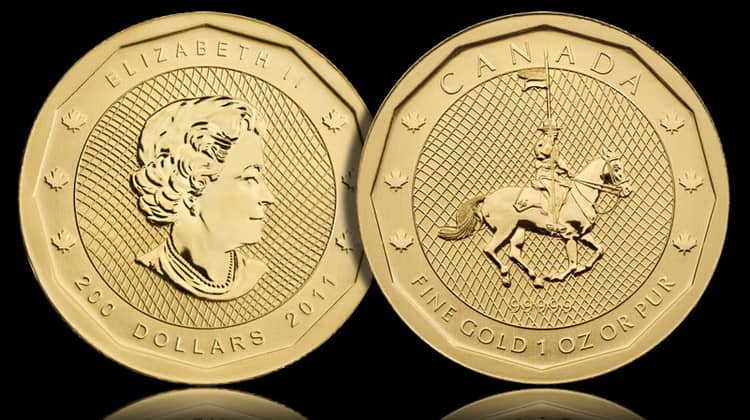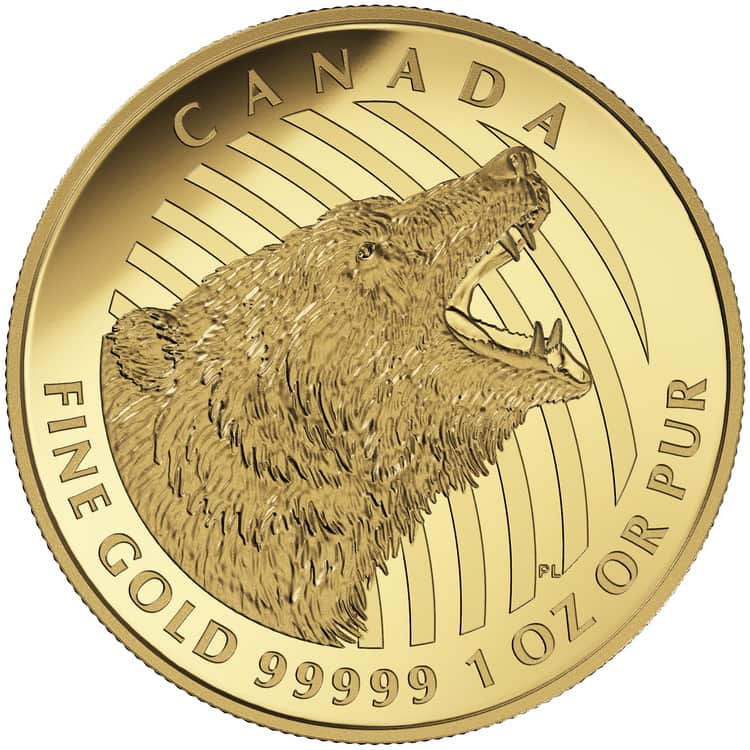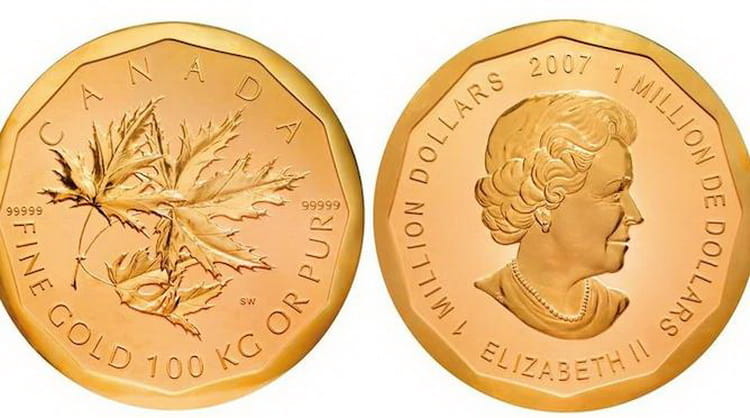
The Canadian coins of the Gold Bar series .99999 are mass-produced by the Mint of the country from 2005 to the present. The first sample of this coin was made in 1998, its test specimens are now stored in the museum of the Mint. Coins have the highest standard, produced in relatively small circulations and are sold mainly at auctions as the investment ones. Today, the coins of .99999 gold purity is considered to be one of the most popular in the world.
“Maple Leaf” series
First issued in 1979, the golden “Maple Leaf” is still highly valued by collectors and investors from all over the world, renowned for its outstanding combination of craftsmanship, cleanliness and design.
Characteristics of the Coins
- Production: Royal Canadian Mint.
- Material: gold .99999.
- Weight: 31.16 g.
- Diameter: 30 mm.
- Obverse: image in profile of Queen Elizabeth II.
Standard Edition
On the reverse of these coins there is the image of a maple leaf − the national symbol of Canada.
- 2005 edition, 50 CAD denomination, circulation 600 samples. (optional − 396). Experimental release.
- 2007 edition, 200 CAD denomination, circulation 500 samples, starting price − 1899 CAD. Experimental release.
- 2007 edition, 200 CAD denomination, circulation 30848 samples.
- 2008 edition, 200 CAD denomination, circulation 1,700 samples, starting price − 1394 CAD. Limited experimental release.
- 2008 edition, 200 CAD denomination, circulation of 27,476 samples. Polyethylene packaging.
- 2009 edition, 200 CAD denomination, circulation 1,365 samples. Polyethylene packaging.
- 2011 edition, 200 CAD denomination, circulation 8408 samples. Special edition devoted to mounted police.
- 2012 edition, 200 CAD denomination CAD, circulation unknown. The reverse is engraved with the same image of a maple leaf as on the 2007 coin.
- 2017 edition, 200 CAD denomination CAD, circulation 500 samples. The background of the reverse of the coin is a recurring number 150 − a mark in honor of the 150th anniversary of the Confederation of Canada.
- 2018 edition, 1, 5, 10, 50 CAD denomination, circulation 600 samples. A set of four coins in one case, made in the form of a maple leaf.
- 2018 edition, 200 CAD denomination, circulation of 375 samples. The coin is dedicated to the 30th anniversary of the release of silver “Maple Leaf”.

“Call Of The Wild” series
From 2014 to the Maple leaf is added the image of animals, personifying the nature of Canada. In fact, the new coins went beyond the standard “maple leaf”, but the Canadian Mint still ranks it among the famous series. On the obverse of all the coins is an image in profile of Queen Elizabeth II.
- 2014 edition, 200 CAD denomination. Experimental release, plastic packaging. On the reverse there is an image of a howling wolf.
- 2014 edition, 200 CAD denomination, circulation 2000 samples. The coins are packed in a maroon clamshell, the image of a howling wolf is engraved on the reverse.
- 2015 edition, 200 CAD denomination. Experimental release, plastic packaging. On the reverse there is an image of a growling cougar.
- 2015 edition, 200 CAD denomination, circulation 250 samples. The coins are packed in a maroon clamshell, the image of a snarling puma is engraved on the reverse.
- 2016 edition, 200 CAD denomination. Experimental release, plastic packaging. On the reverse there is an image of a roaring grizzly.
- 2016 edition, 200 CAD denomination, circulation 250 samples. Coins are packed in a maroon clamshell case. On the reverse there is an image of a roaring grizzly.
- 2017 edition, 200 CAD denomination, circulation 400 samples. Coins are packed in a maroon clamshell case. On the reverse there is an image of a majestic elk.
- 2018 edition, 200 CAD denomination, circulation 400 samples. Coins are packed in a maroon clamshell case. The image of a bighorn sheep is engraved on the reverse.

“Big Maple Leaf” series
Issued in 2007, 1,000,000 CAD denomination, circulation of 6 samples (only 5 samples of the coin went on sale).
The Big Maple Leaf (BML) is a gold coin weighing 100 kilograms (220 pounds and 3.215 troy ounces). The coins were produced by the Royal Canadian Mint (RCM) in 2007 at the plant in Ottawa, where the experimental coin is now stored (the first of six). The remaining coins were quickly sold to investors and collectors. As of March 2017, the market value of one Big Maple Leaf has reached approximately 4 million $ USD.
The size of a Big Maple Leaf is impressive because its thickness is 3 and its diameter is 53 centimeters. The BML obverse depicts Queen Elizabeth II, a portrait that the Mint has minted on its coins since 2003, when Susanna Blunt’s drawing was the third one chosen as the reference for engraving the obverse of the Maple Leaf series. Blunt’s design is not typical, since the Queen is represented without the usual regalia − tiara or crown.

Interesting Facts
- The purity level of 100% silver or gold is an alloy that is considered too soft to produce coins, as a result of which it would be too easy to damage such items. The attempts to make such a coin have never been successful. Thus, .99999 is the recognized highest level of purity for an engraved coin.
- Since the launch of the Maple Leaf series, more than 39 million gold coins have been produced, which is more than 737 kilograms of gold.
- Despite the fact that .99999 sample coins are considered to be more investment than collection coins, the Royal Canadian Mint gives priority to transactions for retail buyers, rather than wholesale dealers.
- In 2013 and 2015, the Mint introduced new security technologies to ensure maximum coin protection against counterfeiting. In 2013, on the reverse of the “Maple Leaf” series coins, special symbols were applied using laser micro-engraving. In the center of the maple leaf there is a figure that coincides with the year of issue of the coin − this figure can only be viewed with a special loupe. In 2015, radial lines were added to both obverse and reverse sides of coins.
- Early in the morning of March 27, 2017, one of the Big Maple Leaves was stolen from the Münzkabinett (coin cabinet) of the Bode Museum in Berlin, Germany. The museum is known for its huge collection of coins − there are more than 500,000 samples, among them more than 100,000 Greek and 50,000 Roman, although only a tiny part of them are regularly shown at exhibitions. A representative of the Canadian Royal Mint said about this: “… the stolen coin does not belong to the Mint. After the original, which is in storage in Ottawa, was created, the Mint produced five more that were sold to interested individuals. As far as I know, the coin was lent to the Bode Museum in 2010 by an unknown private owner and exhibited there until it was stolen”. In July 2017, police raids and arrests were carried out in connection with this theft. According to media reports, the suspects allegedly come from a family known for their criminal past and involved in organized crime. The Berlin police initially assumed that the coin was damaged during the theft, as it was likely thrown off the train at full speed. However, today investigators no longer expect to find a coin, since gold dust was found on the clothes and in the car of the detained suspects. It is believed that a Big Maple Leaf just melted. As of March 27, 2018, the coin was not found and the suspect has not yet been charged.
Comments
No commens yet.